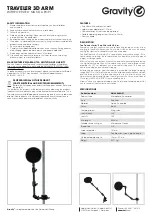
10
about 3%-9% (Govindgee 2004) of the light energy absorbed by chlorophyll pigments as
chlorophyll fluorescence. Healthy plants in a healthy environment will use most light energy
for photochemistry. More stressful environments will channel additional energy to heat
dissipation and fluorescence.
This effect was first observed more than 100 years ago, when N.J.C. Müller (1874), using
colored glass filters, studied the phenomenon. He also noted that fluorescence changes that
occur in green leaves was related to photosynthetic assimilation. Lack of appropriate
technical equipment prevented a more detailed investigation.
The basic OS1p is equipped to make several different kinds of tests including: Dark-adapted
Fv/Fm, Light adapted Yield (Y) or
)
F/Fm’ or Y(II), Fo, Fm, Fms (or Fm’), Fs (or F’).It will
also measure fluorescence quenching, and rapid light curves.
PAR Clips are sold separately, and are required for ETR, PAR, and Leaf temperature.
PAR Clips are highly recommended for field measurement of Y(II) and ETR. Because Y(II)
values vary not only with plant stress, but also with light level and temperature, only samples
at very similar light levels and light histories should be compared. Sun leaves will respond
differently than shade leaves to different light levels.
The ability to use Rapid light curves will be provided in 2011 without additional charge for
those that buy the advanced version of the OS1p. The advanced version also allows the user
to select quenching protocols of interest when the unit is purchased. Other Protocols may also
be purchased during or after the initial purchase. Fod (or Fo’) are provided in the Kramer, and
puddle model quenching protocols. The default quenching protocol that is offered on the
advanced version of the OS1p is the Luke Hendrickson – Klughammer simplified lake model.
This provides the most versatile quenching solution because it includes NPQ that has been
resurrected from the puddle model. Other protocols are available for an additional charge.
One may replace the Hendrickson protocol with either the Kramer protocol or the puddle
model protocol at the time of purchase for no additional charge.
The quenching options include:
1. Dave Kramer’s lake model parameters (Kramer 2004) - Y(II), qL, Y(NPQ), and Y(NO)
2. Luke Hendrickson’s lake model parameters with Klughammer’s resurrection of NPQ from
the puddle model are included in this protocol - Y(II), Y(NPQ),Y(NO), and NPQ.
3. Puddle model quenching parameters qN, qP, and NPQ.
4. A relaxation protocol for subdividing NPQ into q
E
, q
T
, and q
I.
This protocol may be used
with NPQ in either the puddle model, or the Hendrickson lake model. The test runs at the
same time as the protocols mentioned above. To use this protocol either the Hendrickson or
puddle model protocols must also be purchased.
Содержание OS1p
Страница 108: ...108 Setting saturation pulse width...
Страница 148: ...148 Microsoft Windows Screen on a PC Microsoft Windows Screen on a PC Select Excel...
Страница 173: ...173 Y II data file format...
Страница 174: ...174 Quenching data file format Hendrickson Klughammer equations...
Страница 175: ...175 RCL Rapid Light Curve data format...











































